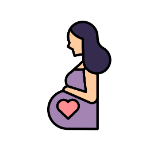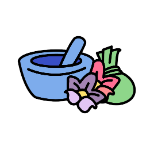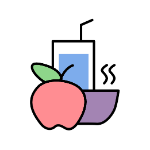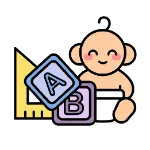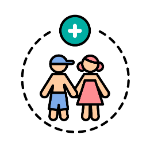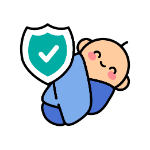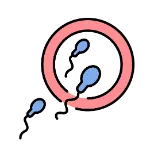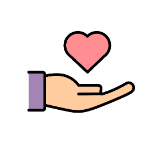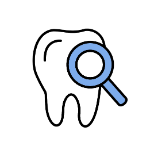
Healing Tips For Nipple
Tips To Treat Cracked Nipples And Get Increase Comfort
8 min | Updated on 15-02-2022 by HappyPreggie
Childbirth is no stroll in the park, as everyone knows. However, you may not have expected to have difficulties during nursing. Breastfeeding may go wrong in a variety of ways, with cracked nipples being one of the most common.

(Image credits to Canva)
If you have cracked nipples, you already know how unpleasant and painful, it could be. You want relief so that you can continue breastfeeding your baby in comfort and keep both of you happy! In this post, we'll discuss how to care for cracked nipples in a safe and natural method. But before we get into how to cure cracked nipples, it's crucial to know why you have them in the first place.
Breastfeeding mistakes are the most common cause of cracked nipples, however, this isn't always the case. During the first month following birth, this painful and unpleasant condition is most common. Your nipples will take some time to recover, so don't anticipate rapid and long-lasting comfort. However, by looking at our natural cure suggestions, you can get fast, temporary relief.

(Image credits to MamaXpert)
Remember, when it comes to recovering properly, the most essential thing is to go to the source of the problem. Don't quit nursing your baby just because your cracked nipples seem to be getting worse! You've got this! Your skin may recover quickly with the proper help. In the meanwhile, keep reading to learn more about what causes cracked nipples and how to treat them.
First and foremost, even if a woman isn't nursing, she might have sore nipples. If this fits you, the issue might be caused by rubbing or discomfort (such as by wearing the improper bra), a bacterial or fungal infection, or nipple eczema.
When it comes to eczema, don't be concerned if it runs in your family and your child has it as well. We've got you covered when it comes to clothing, bathing, and quick cleanups for your eczema-prone infant. If you're breastfeeding and you notice a small crack or cut on your nipple, there are a few things that could be causing it.
Cracked nipples are commonly caused by incorrect latching. The baby's mouth should be over your entire nipple and part of the areola when they latch on to your breast to nurse. This positions your nipple towards the rear of their mouth, where it won’t be irritated.

(Image credits to Women Health Care)
Because your baby (and you!) is still learning how to nurse, it may take some time and a few tries for them to latch on to your breast correctly. And due to the repetitive sucking motion and modifications, your nipples tend to grow painful rapidly. This can lead them to break over time. It's ideal to nail down the right latch and position before you and your baby leave the hospital to minimize latching issues at home. To do so, contact the lactation consultant or inform your nurse that you'd like to speak with them.
If you and your little one simply can’t seem to get the hang of latching on correctly, it might be that your baby has an issue with their mouth. A problem like a tongue tie, lip tie, or high palate could make it challenging for them to breastfeed effectively.

(Image credits to What To Expect)
Your child becomes bewildered and confused about which sort of nipple he or she is sucking on, which is known as nipple confusion. If you're breastfeeding and simultaneously giving your baby a bottle or a pacifier, your infant may struggle to move between the two and figure out how to latch on to your breast. It's no surprise, given the size and texture difference between a mother's nipple and the nipple of a bottle or pacifier!
Avoiding giving your infant a pacifier during the first few weeks after delivery, especially if you're nursing, is one strategy to minimize nipple confusion. They won't have any nipple confusion if your nipple — or the nipple on the bottle — is the only nipple they've ever seen.
If you’re using a breast pump, your baby’s mouth isn’t the only thing latching on to your nipple. Using the incorrect size of breast shield or a too-high suction level might irritate your nipples.

(Image credits to FirstCry Parenting)
Allowing your body some time to adjust to your baby's requirements is crucial. Pumping should be avoided as much as possible during the first several days to ensure a plentiful milk supply. Your body is incredible and will provide everything your baby requires! Not only can over-pumping hurt your nipples, but it can also cause milk supply to be disrupted for your baby.
When it comes to nursing, you and your child must be on the same page. They're figuring it out, and you're doing the same! You're most likely agitated and uncomfortable during breastfeeding if your nipples are cracked and painful. Your baby will pick up on your anxiety and get agitated, making it more difficult to fix their latch and posture.

(Image credits to Canva)
The good news is that, once you're relaxed, changing your baby's latch and posture is simple with the assistance of a nurse or lactation consultant, as we previously discussed. Even if your baby is finally latching on correctly, please remember that your nipples may still ache. This is because your nipples will take some time to recover completely. But, before you know it, you and your baby will have mastered the art of nursing!
Apply ice to your nipples before breastfeeding to help with the early pain of the newborn latching on. Before you start breastfeeding, the ice will help numb the region and take the sting out of it. Wrap a couple of ice cubes in a light cloth or towel and press them gently on your skin for a few minutes. You may do this before and after meals, as well as at any time during the day.

(Image credits to Canva)
Cold cabbage leaves are also a good choice because they've been shown to aid with pain and inflammation relief. When you lie down, place a few cabbage leaves on the inside of your nursing bra or on top of your breasts.
Apply a warm compress after your baby has been breastfed, rather than a cold compress before. The warmth may provide brief comfort for your aching nipples. Soak a towel in warm water and squeeze away the excess. Place the warm towel over your nipples gently and let it there for a few minutes. Pat your nipples dry after removing the towel.
If breastfeeding or pumping is too painful, consider hand-expressing your breast milk before nursing if all else fails. It's critical to discharge your breast milk in some way. Your nipples won't be the only uncomfortable spot on your body if you let the milk build-up! Milk build-up may be highly unpleasant for your breasts, and it can make latching on your infant even more difficult.
It's possible that both of your nipples are hurting, in which case it doesn't matter which one you start feeding your baby with. However, if one side hurts more than the other, start with the side that aches the least. Because they won't be as hungry, they'll feed more softly on the second breast.

(Image credits to Canva)
The most natural thing to utilize when it comes to soothing and healing items to your painful nipples is your own breast milk! After feeding your infant, dab a few drops of breastmilk into your nipples and let them air dry. Breast milk is antimicrobial, and it's also quite handy! If you have thrush, don't use breast milk.

(Image credits to Canva)
Another technique to aid the healing process is to rinse your nipples with saltwater. Simply dissolve half a teaspoon of salt in a glass of warm water (six or eight ounces) to produce fresh saltwater. Then, using a cotton ball or a spray bottle, apply the saltwater to your nipples. Alternatively, you might put the saltwater in a basin and soak your nipples for a minute or two. If your infant doesn't like the salty taste, rinse your nipples before breastfeeding.
Make sure the bra you're wearing isn't too tight or too scratchy. You want to be as gentle as possible with your nipples! Another technique to heal cracked nipples is to completely clean your bras after washing them. Why? The detergent residue left on your bra may irritate your skin even more.

(Image credits to Canva)
We know that cracked nipples can be excruciatingly painful, but with proper care, this problem can often be treated at home. As a new mother, it's critical to look for yourself so that you can look after your child. If you follow the steps above to cure your painful, cracked nipples, you and your baby will be back to enjoying the beautiful moments that breastfeeding gives in no time!
If you loved reading this article you might also like- 10 Best Baby Strollers In Malaysia or the 10 Best Nursing Pillows In Malaysia.
(Image credits to Canva)
If you have cracked nipples, you already know how unpleasant and painful, it could be. You want relief so that you can continue breastfeeding your baby in comfort and keep both of you happy! In this post, we'll discuss how to care for cracked nipples in a safe and natural method. But before we get into how to cure cracked nipples, it's crucial to know why you have them in the first place.
Things You Need To Know About Cracked Nipples
Breastfeeding mistakes are the most common cause of cracked nipples, however, this isn't always the case. During the first month following birth, this painful and unpleasant condition is most common. Your nipples will take some time to recover, so don't anticipate rapid and long-lasting comfort. However, by looking at our natural cure suggestions, you can get fast, temporary relief.
(Image credits to MamaXpert)
Remember, when it comes to recovering properly, the most essential thing is to go to the source of the problem. Don't quit nursing your baby just because your cracked nipples seem to be getting worse! You've got this! Your skin may recover quickly with the proper help. In the meanwhile, keep reading to learn more about what causes cracked nipples and how to treat them.
The Causes Of Cracked Nipples
First and foremost, even if a woman isn't nursing, she might have sore nipples. If this fits you, the issue might be caused by rubbing or discomfort (such as by wearing the improper bra), a bacterial or fungal infection, or nipple eczema.
When it comes to eczema, don't be concerned if it runs in your family and your child has it as well. We've got you covered when it comes to clothing, bathing, and quick cleanups for your eczema-prone infant. If you're breastfeeding and you notice a small crack or cut on your nipple, there are a few things that could be causing it.
#1 Incorrect Breastfeeding Position
Cracked nipples are commonly caused by incorrect latching. The baby's mouth should be over your entire nipple and part of the areola when they latch on to your breast to nurse. This positions your nipple towards the rear of their mouth, where it won’t be irritated.
(Image credits to Women Health Care)
Because your baby (and you!) is still learning how to nurse, it may take some time and a few tries for them to latch on to your breast correctly. And due to the repetitive sucking motion and modifications, your nipples tend to grow painful rapidly. This can lead them to break over time. It's ideal to nail down the right latch and position before you and your baby leave the hospital to minimize latching issues at home. To do so, contact the lactation consultant or inform your nurse that you'd like to speak with them.
#2 Tongue-tie And Other Mouth Conditions
If you and your little one simply can’t seem to get the hang of latching on correctly, it might be that your baby has an issue with their mouth. A problem like a tongue tie, lip tie, or high palate could make it challenging for them to breastfeed effectively.
(Image credits to What To Expect)
#3 Nipple Confusion
Your child becomes bewildered and confused about which sort of nipple he or she is sucking on, which is known as nipple confusion. If you're breastfeeding and simultaneously giving your baby a bottle or a pacifier, your infant may struggle to move between the two and figure out how to latch on to your breast. It's no surprise, given the size and texture difference between a mother's nipple and the nipple of a bottle or pacifier!
Avoiding giving your infant a pacifier during the first few weeks after delivery, especially if you're nursing, is one strategy to minimize nipple confusion. They won't have any nipple confusion if your nipple — or the nipple on the bottle — is the only nipple they've ever seen.
#4 Using Your Breast Pump In The Wrong Way
If you’re using a breast pump, your baby’s mouth isn’t the only thing latching on to your nipple. Using the incorrect size of breast shield or a too-high suction level might irritate your nipples.
(Image credits to FirstCry Parenting)
Allowing your body some time to adjust to your baby's requirements is crucial. Pumping should be avoided as much as possible during the first several days to ensure a plentiful milk supply. Your body is incredible and will provide everything your baby requires! Not only can over-pumping hurt your nipples, but it can also cause milk supply to be disrupted for your baby.
Natural Remedies To Treat Cracked Nipples
#1 Find the perfect breastfeeding position
When it comes to nursing, you and your child must be on the same page. They're figuring it out, and you're doing the same! You're most likely agitated and uncomfortable during breastfeeding if your nipples are cracked and painful. Your baby will pick up on your anxiety and get agitated, making it more difficult to fix their latch and posture.
(Image credits to Canva)
The good news is that, once you're relaxed, changing your baby's latch and posture is simple with the assistance of a nurse or lactation consultant, as we previously discussed. Even if your baby is finally latching on correctly, please remember that your nipples may still ache. This is because your nipples will take some time to recover completely. But, before you know it, you and your baby will have mastered the art of nursing!
#2 Apply Ice Before You Breastfeed
Apply ice to your nipples before breastfeeding to help with the early pain of the newborn latching on. Before you start breastfeeding, the ice will help numb the region and take the sting out of it. Wrap a couple of ice cubes in a light cloth or towel and press them gently on your skin for a few minutes. You may do this before and after meals, as well as at any time during the day.
(Image credits to Canva)
Cold cabbage leaves are also a good choice because they've been shown to aid with pain and inflammation relief. When you lie down, place a few cabbage leaves on the inside of your nursing bra or on top of your breasts.
#3 After Breastfeeding, Apply a Warm Compress
Apply a warm compress after your baby has been breastfed, rather than a cold compress before. The warmth may provide brief comfort for your aching nipples. Soak a towel in warm water and squeeze away the excess. Place the warm towel over your nipples gently and let it there for a few minutes. Pat your nipples dry after removing the towel.
#4 Hand Express Your Milk
If breastfeeding or pumping is too painful, consider hand-expressing your breast milk before nursing if all else fails. It's critical to discharge your breast milk in some way. Your nipples won't be the only uncomfortable spot on your body if you let the milk build-up! Milk build-up may be highly unpleasant for your breasts, and it can make latching on your infant even more difficult.
The danger of your breasts getting engorged (overfull and firm) and developing mastitis is reduced by releasing this build-up. This also aids in the maintenance of your milk production as well as the relief of painful and cracked nipples over time.
#5 Start With The Healthy Side Of The Breast
It's possible that both of your nipples are hurting, in which case it doesn't matter which one you start feeding your baby with. However, if one side hurts more than the other, start with the side that aches the least. Because they won't be as hungry, they'll feed more softly on the second breast.
(Image credits to Canva)
#6 Apply Breast Milk
The most natural thing to utilize when it comes to soothing and healing items to your painful nipples is your own breast milk! After feeding your infant, dab a few drops of breastmilk into your nipples and let them air dry. Breast milk is antimicrobial, and it's also quite handy! If you have thrush, don't use breast milk.
(Image credits to Canva)
#7 Wash It With Saltwater
Another technique to aid the healing process is to rinse your nipples with saltwater. Simply dissolve half a teaspoon of salt in a glass of warm water (six or eight ounces) to produce fresh saltwater. Then, using a cotton ball or a spray bottle, apply the saltwater to your nipples. Alternatively, you might put the saltwater in a basin and soak your nipples for a minute or two. If your infant doesn't like the salty taste, rinse your nipples before breastfeeding.
#8 Wear The Right Bra
Make sure the bra you're wearing isn't too tight or too scratchy. You want to be as gentle as possible with your nipples! Another technique to heal cracked nipples is to completely clean your bras after washing them. Why? The detergent residue left on your bra may irritate your skin even more.
(Image credits to Canva)
We know that cracked nipples can be excruciatingly painful, but with proper care, this problem can often be treated at home. As a new mother, it's critical to look for yourself so that you can look after your child. If you follow the steps above to cure your painful, cracked nipples, you and your baby will be back to enjoying the beautiful moments that breastfeeding gives in no time!
If you loved reading this article you might also like- 10 Best Baby Strollers In Malaysia or the 10 Best Nursing Pillows In Malaysia.
Join the largest support network for family health and well-being. Ready to get started?
Get started
